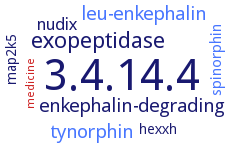3.4.14.4: dipeptidyl-peptidase III
This is an abbreviated version!
For detailed information about dipeptidyl-peptidase III, go to the full flat file.

Word Map on EC 3.4.14.4 
-
3.4.14.4
-
exopeptidase
-
tynorphin
-
enkephalin-degrading
-
leu-enkephalin
-
nudix
-
spinorphin
-
hexxh
-
map2k5
-
medicine
- 3.4.14.4
-
exopeptidase
- tynorphin
-
enkephalin-degrading
- leu-enkephalin
-
nudix
- spinorphin
-
hexxh
-
map2k5
- medicine
Reaction
release of an N-terminal dipeptide from a peptide comprising four or additional information residues, with broad specificity. Also acts on dipeptidyl 2-naphthylamides. =
Synonyms
BT_1846, Cabys_2252, dipeptdiyl peptidase III, dipeptidyl aminopeptidase III, dipeptidyl arylamidase III, dipeptidyl peptidase III, dipeptidyl-peptidase III, dipeptidyl-peptide hydrolase, dipeptidylpeptidase III, DPP III, DPP-3, DPP-III, DPP3, DPPIII, enkephalinase B, NUDT3, peptidase, dipeptidyl, III, PG_0317, PHYPA_007037, red cell angiotensinase
ECTree
Advanced search results
Engineering
Engineering on EC 3.4.14.4 - dipeptidyl-peptidase III
Please wait a moment until all data is loaded. This message will disappear when all data is loaded.
C450S
-
residues Gly383 and Glu320 form significantly less hydrogen bonds with substrate Arg-Arg-2-naphthylamide than in the wild type enzyme
D372A
residue Asp372 plays a crucial role in the large scale interdomain closure. During the MD simulation time, the variant remains more open than the wild type protein. Apparently, Ala is not as efficient as Asp in establishing the interdomain interactions
D496G
-
mutation in S2 subsite, mutant has lost selectivity due to the increase of the Km value. Mutant shows significantly decreased binding of peptides with N-terminal arginine, and of tynorphin
G313A
mutation detected in human cancer, strong decrease in activity. Mutation significantly increases the enzyme flexibility, particularly that of the binding site including the H450ELLGH455 motif, and influences the substrate interactions with the catalytic His568
R510K
mutation detected in human cancer, substitution mildly decreases enzyme activity for Arg-Arg-2-naphtylamide substrate
R510W
mutation detected in human cancer, almost abolishes activity. Mutation significantly increases the enzyme flexibility, particularly that of the binding site including the H450ELLGH455 motif, and influences the substrate interactions with the catalytic His568
S504G
-
mutation in S2 subsite, mutant does not show decreased binding of peptides with N-terminal arginine
W300F
mutant with slight increase in activity compared to wild-type enzyme
Y318F
the potential functional role of the well-conserved tyrosine 318 residue in the active center of human DPP III is investigated
Y395F
the potential functional role of the well-conserved tyrosine 395 residue in the active center of human DPP III is investigated
Y644F
the potential functional role of the well-conserved tyrosine 644 residue in the active center of human DPP III is investigated
C176A
-
25-35% of wild type activity, resistant against p-chloro-mercuri-benzoate and N-ethylmaleimide
Leu453del
-
activity of mutant Cu(II)-del-DPP III, in which Leu453 is deleted from the metal-binding motif, is only 1-2% of the enzyme activity of del-DPP. The EPR spectra of Cu(II) del-DPP III do not change in the presence of excess Lys-Ala-beta-naphthylamide. The deletion of Leu453 from the HELLGH motif of rat DPP III leads to a complete loss of flexibility in the ligand geometry around the cupric ions
C130S
H578D
mutation 122fold lowers the catalytic efficiency for Arg-Arg 2-naphthylamide hydrolysis, and 14fold decreases affinity for hydroxamate inhibitor Tyr-Phe-NHOH
K638L
mutation slightly increases the specificity constant for Arg-Arg 2-naphthylamide hydrolysis. The affinity for Tyr-Phe-NHOH, and activity for the substrates with uncharged P2 side chains such as Ala-Ala-, Ala-Arg- and Phe-Arg 2-naphthylamide are dramatically reduced
R582Q
mutant exhibits an order of magnitude higher activity with all four dipeptide derivatives examined, compared to the wild type, due to a change in the H-bond networking in the R582Q variant active-site region
C130S
-
the mutant exhibits comparable enzymatic activity to the wild type protein
-
additional information
-
the mutant exhibits comparable enzymatic activity to the wild type protein
design of recombinant enzymes withh binding of Ets-1/Elk-1 proteins to binding motifs, increased enzyme expression
additional information
-
design of recombinant enzymes withh binding of Ets-1/Elk-1 proteins to binding motifs, increased enzyme expression
additional information
DPPIII6His, construct with hexahistidine


 results (
results ( results (
results ( top
top






